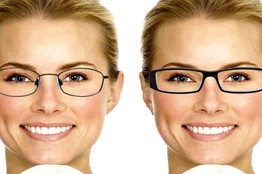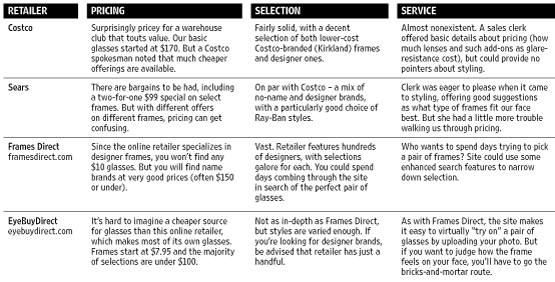The Wall Street Journal - On the Lookout for Inexpensive Eyeglasses
By CHARLES PASSY
Perhaps the designer look is prized by some style-conscious folks seeking a new set of spectacles. But what if you just want a spare pair of glasses on the cheap?
Apparently, it’s a common dilemma: In 2008, sales of vision-care products and services at optical retail outlets topped $25.8 billion—a modest increase of $73 million from the previous year, according to the VisionWatch trade report. But some retailers that specialize in discount eyewear are enjoying robust growth: EyeBuyDirect, an online retailer based in Bethesda, Md., that offers prescription glasses for as little as $6.95 a pair, reports that its sales have risen 900% since its inception in 2006.

With that in mind, we decided to visit four cost-conscious retailers—online and in person—to see what their pricing (for frame and lenses combined), service and selection was like for men’s glasses. We asked them to suggest the least-expensive pair possible, but we also asked them to volunteer a recommendation for a designer pair of prescription sunglasses—just in case we wanted to make a fashion statement this summer.
First, however, we opted to visit a mom-and-pop eyewear retailer near our South Florida home, so we would have a basis for comparison. At Lima Vision Center in West Palm Beach, we were treated courteously, despite the hubbub of customers going to and from the in-house optometrist for eye exams. A salesperson zoned in on a couple of selections right away, suggesting a generic-looking $119 pair of no-name eyeglasses as our bargain pick and a $259 manly, modern Republica pair for our designer shades. The biggest drawback was that if we wanted other options, the selection was limited—just a few rows worth of choices for men—and there wasn’t much space to comfortably browse. We had trouble finding a mirror.
At a couple of major bricks-and-mortar retailers, we found a much better selection. But we also found higher or harder-to-decipher pricing and service issues of other kinds. At Costco, the wholesale club that features optical centers within its warehouse-style locations, our cheap pair wasn’t so cheap. The best we could do was $170 to $180, going with the company’s in-house brand (Kirkland) of frames (fortunately, there were several styles at the price level). For sunglasses, we were told to simply add another $50 to the equation for polarized lenses (and if we wanted a designer option, there were frames from such names as Kenneth Cole, Stetson and Van Heusen at higher prices). But as is often the case at Costco, service—or lack thereof—was a sticking point, since the retailer is known for taking a hands-off approach.
A Costco Wholesale Corp. spokesman said the figures we were quoted were not necessarily bottom-line prices—and that costs can run as low as $68 for glasses and $105 for sunglasses. “What was likely happening was that our optician was guiding you to the best eyeglasses for you,” he said, noting that there can be added charges for such upgrades as nonglare treatment. As far as our not being offered guidance regarding style, he said, “We expect our opticians to help our members pick out eyeglasses.”
With Sears, we found a much more helpful sales rep, who took the time to explain what kind of designs best suited us. But getting her attention was the trickier part: Since she was the only clerk on duty, we had to wait more than 30 minutes to have a lengthy discussion. And even then, we walked away a bit confused about the pricing, since the chain has various specials. We were told we could buy any set of frames, including designer brands, for $199. But we were also told we could choose from a less-stylish selection of frames for a special two-for-one price of $99. And we could add a pair of prescription sunglasses—any style—to an order for $149.
But what if we wanted one of the two-for-one pairs to be our sunglasses? The clerk tried to explain how certain surcharges would kick in, but the math got very complicated. In the end, she advised us to pick what we liked and she would try to offer the best deal. A Sears Holding Corp. spokesman explained that since every customer’s needs are different, not every offer may fit.
All that waiting and discussing of prices started to make the online route seem like a good alternative. Granted, shopping for specs without trying them on takes a leap of faith. (And it requires that you carefully plug in all the details from your prescription.) But we were impressed at how two leading companies, Frames Direct (FramesDirect.com) and the aforementioned EyeBuyDirect (EyeBuyDirect.com), made the process much easier by allowing you to upload a photo of yourself on the site and then “try on” the frames virtually. Surprisingly, you do get a good sense of how the glasses fit your face.
But best of all, the online retailers offer some exceptional buys. Frames Direct, Houston, Texas, focuses on designer brands—several hundred in all, from A (A&A Optical) to Z (Zyloware). Naturally, designer specs cost more, but plenty of bargains can be had on the site: We found lots of frames for less than $150—and a pair of Republica sunglasses for less than $125 that were seemingly identical to the ones we saw at the mom-and-pop retailer.
With EyeBuyDirect, the savings can be even deeper because the retailer sells mainly its own frames—most priced at $100 or less, with some selections indeed priced as little as $6.95. The styles often mimic the designer ones, though selection is not quite as deep (around 400 styles in all) as Frames Direct.
Which is not to say either online retailer is perfect. We were bothered by the fact that Frames Direct made it impossible to search by price range—you just had to pick one of the several designers and scroll through the entire array of styles. (A spokesman says improvements to the site are in the works.) And EyeBuyDirect all but concedes the limitations of shopping for eyewear online: If you need to adjust your frames in any way after receiving them, the retailer suggests “walking into a nearby optical center,” adding that in “most places they will be happy to assist you free of charge.”
Buy the glasses online, but try to have a bricks-and-mortar retailer handle the adjusting at no cost? That sounds a little short-sighted to us.


